brake HUMMER H2 2007 Owners Manual
[x] Cancel search | Manufacturer: HUMMER, Model Year: 2007, Model line: H2, Model: HUMMER H2 2007Pages: 570, PDF Size: 3.34 MB
Page 93 of 570
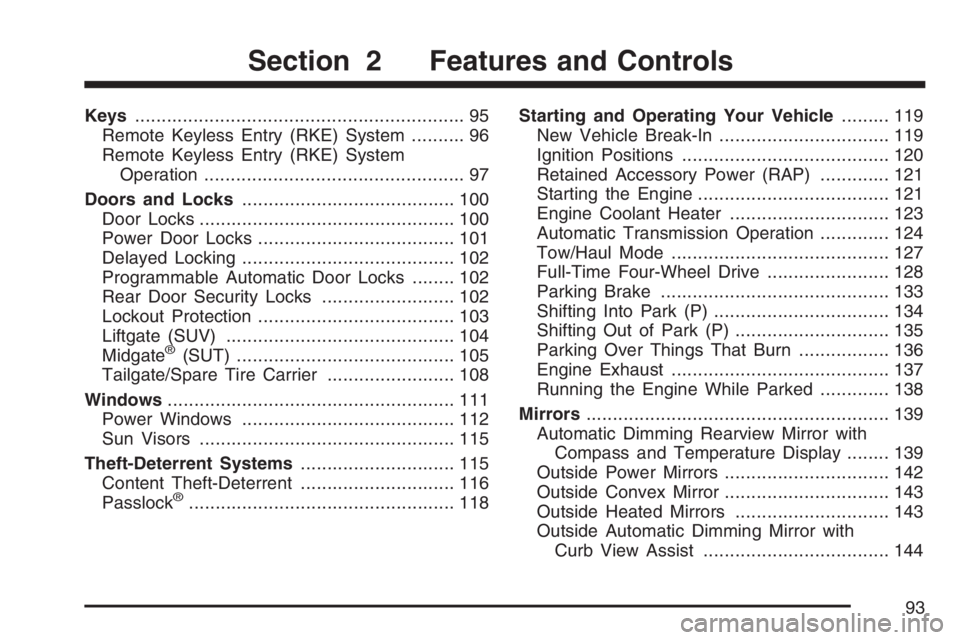
Keys.............................................................. 95
Remote Keyless Entry (RKE) System.......... 96
Remote Keyless Entry (RKE) System
Operation................................................. 97
Doors and Locks........................................ 100
Door Locks................................................ 100
Power Door Locks..................................... 101
Delayed Locking........................................ 102
Programmable Automatic Door Locks........ 102
Rear Door Security Locks......................... 102
Lockout Protection..................................... 103
Liftgate (SUV)........................................... 104
Midgate
®(SUT)......................................... 105
Tailgate/Spare Tire Carrier........................ 108
Windows...................................................... 111
Power Windows........................................ 112
Sun Visors................................................ 115
Theft-Deterrent Systems............................. 115
Content Theft-Deterrent............................. 116
Passlock
®.................................................. 118Starting and Operating Your Vehicle......... 119
New Vehicle Break-In................................ 119
Ignition Positions....................................... 120
Retained Accessory Power (RAP)............. 121
Starting the Engine.................................... 121
Engine Coolant Heater.............................. 123
Automatic Transmission Operation............. 124
Tow/Haul Mode......................................... 127
Full-Time Four-Wheel Drive....................... 128
Parking Brake........................................... 133
Shifting Into Park (P) ................................. 134
Shifting Out of Park (P)............................. 135
Parking Over Things That Burn................. 136
Engine Exhaust......................................... 137
Running the Engine While Parked............. 138
Mirrors......................................................... 139
Automatic Dimming Rearview Mirror with
Compass and Temperature Display........ 139
Outside Power Mirrors............................... 142
Outside Convex Mirror............................... 143
Outside Heated Mirrors............................. 143
Outside Automatic Dimming Mirror with
Curb View Assist................................... 144
Section 2 Features and Controls
93
Page 119 of 570

Starting and Operating Your
Vehicle
New Vehicle Break-In
Notice:Your vehicle does not need an
elaborate break-in. But it will perform better in
the long run if you follow these guidelines:
Keep your speed at 55 mph (88 km/h)
or less for the �rst 500 miles (805 km).
Do not drive at any one constant speed,
fast or slow, for the �rst 500 miles
(805 km). Do not make full-throttle starts.
Avoid downshifting to brake, or slow,
the vehicle.
Avoid making hard stops for the �rst
200 miles (322 km) or so. During this time
your new brake linings are not yet
broken in. Hard stops with new linings can
mean premature wear and earlier
replacement. Follow this breaking-in
guideline every time you get new brake
linings.
Do not tow a trailer during break-in. See
Towing a Trailer on page 374for the
trailer towing capabilities of your vehicle
and more information.
Following break-in, engine speed and load can
be gradually increased.
119
Page 124 of 570

Automatic Transmission Operation
Your vehicle is equipped with an automatic
transmission and features an electronic shift
position indicator located within the instrument
panel cluster.
There are several different positions for your
shift lever.
PARK (P):This position locks your drive wheels. It
is the best position to use when you start your
engine because your vehicle cannot move easily.
{CAUTION:
It is dangerous to get out of your vehicle
if the shift lever is not fully in PARK (P)
with the parking brake �rmly set. Your
vehicle can roll.
Do not leave your vehicle when the engine
is running unless you have to. If you have
left the engine running, the vehicle can
move suddenly. You or others could be
injured. To be sure your vehicle will not
move, even when you are on fairly level
ground, always set your parking brake
and move the shift lever to PARK (P). See
Shifting Into Park (P) on page 134.Ifyou
are pulling a trailer, seeTowing a Trailer
on page 374.
124
Page 125 of 570

{CAUTION:
Shifting the transfer case to NEUTRAL
can cause your vehicle to roll even if the
transmission is in PARK (P). You or
someone else could be seriously injured.
Be sure to set the parking brake before
placing the transfer case in NEUTRAL.
SeeParking Brake on page 133.
REVERSE (R):Use this gear to back up.
Notice:Shifting to REVERSE (R) while your
vehicle is moving forward could damage
the transmission. The repairs would not be
covered by your warranty. Shift to
REVERSE (R) only after your vehicle is
stopped.
To rock your vehicle back and forth to get out
of snow, ice or sand without damaging your
transmission, seeIf Your Vehicle is Stuck in
Sand, Mud, Ice, or Snow on page 357.NEUTRAL (N):In this position, your engine does
not connect with the drive wheels. To restart when
you are already moving, use NEUTRAL (N) only.
{CAUTION:
Shifting into a drive gear while your
engine is running at high speed is
dangerous. Unless your foot is �rmly on
the brake pedal, your vehicle could move
very rapidly. You could lose control and
hit people or objects. Do not shift into a
drive gear while your engine is running at
high speed.
Notice:Shifting out of PARK (P) or
NEUTRAL (N) with the engine running at high
speed may damage the transmission. The
repairs would not be covered by your warranty.
Be sure the engine is not running at high
speed when shifting your vehicle.
125
Page 126 of 570

DRIVE (D):This position is for normal driving. It
provides the best fuel economy for your vehicle. If
you need more power for passing, and you are:
Going less than about 35 mph (55 km/h),
push your accelerator pedal about
halfway down.
Going about 35 mph (55 km/h) or more, push
the accelerator all the way down.
You will shift down to the next gear and have
more power.
Downshifting the transmission in slippery road
conditions could result in skidding, see “Skidding”
underLoss of Control on page 316.
DRIVE (D) can be used when towing a trailer,
carrying a heavy load, driving on steep hills or for
off-road driving. You may want to shift the
transmission to THIRD (3) or, if necessary, a lower
gear selection if the transmission shifts too often.THIRD (3):This position is used for normal
driving. It reduces vehicle speed more than
DRIVE (D) without using your brakes. You might
choose THIRD (3) instead of DRIVE (D) when
driving on hilly, winding roads, when towing
a trailer, so there is less shifting between gears
and when going down a steep hill.
SECOND (2):This position reduces vehicle speed
even more than THIRD (3) without using your
brakes. You can use SECOND (2) on hills. It can
help control your speed as you go down steep
mountain roads, but then you would also want to
use your brakes off and on.
If you manually select SECOND (2), the
transmission will drive in second gear. You may
use this feature for reducing the speed of the rear
wheels when you are trying to start your vehicle
from a stop on slippery road surfaces. Once
the vehicle is moving, shift into DRIVE (D).
126
Page 127 of 570

FIRST (1):This position reduces vehicle speed
even more than SECOND (2) without using
your brakes. You can use it on very steep hills, or
in deep snow or mud. If the shift lever is put in
FIRST (1) while the vehicle is moving forward, the
transmission will not shift into �rst gear until the
vehicle is going slowly enough.
Notice:Spinning the tires or holding the
vehicle in one place on a hill using only the
accelerator pedal may damage the
transmission. The repair will not be covered by
your warranty. If you are stuck, do not spin
the tires. When stopping on a hill, use the
brakes to hold the vehicle in place.
On cold days, approximately 32°F (0°C) or colder,
your transmission is designed to shift differently
until the engine reaches normal operating
temperature. This is intended to improve heater
performance.Tow/Haul Mode
Your vehicle is equipped
with a tow/haul mode.
The button is located on
the instrument panel
to the right of the
steering wheel.
You can use this feature to assist when towing or
hauling a heavy load. See “Tow/Haul Mode”
underTowing a Trailer on page 374for more
information.
127
Page 129 of 570
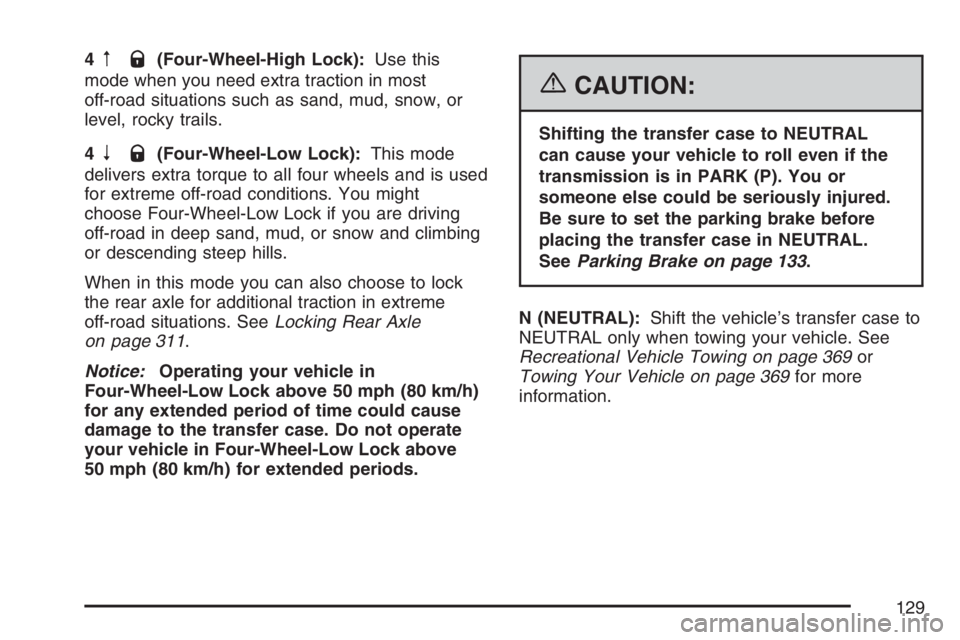
4mQ(Four-Wheel-High Lock):Use this
mode when you need extra traction in most
off-road situations such as sand, mud, snow, or
level, rocky trails.
4
nQ(Four-Wheel-Low Lock):This mode
delivers extra torque to all four wheels and is used
for extreme off-road conditions. You might
choose Four-Wheel-Low Lock if you are driving
off-road in deep sand, mud, or snow and climbing
or descending steep hills.
When in this mode you can also choose to lock
the rear axle for additional traction in extreme
off-road situations. SeeLocking Rear Axle
on page 311.
Notice:Operating your vehicle in
Four-Wheel-Low Lock above 50 mph (80 km/h)
for any extended period of time could cause
damage to the transfer case. Do not operate
your vehicle in Four-Wheel-Low Lock above
50 mph (80 km/h) for extended periods.
{CAUTION:
Shifting the transfer case to NEUTRAL
can cause your vehicle to roll even if the
transmission is in PARK (P). You or
someone else could be seriously injured.
Be sure to set the parking brake before
placing the transfer case in NEUTRAL.
SeeParking Brake on page 133.
N (NEUTRAL):Shift the vehicle’s transfer case to
NEUTRAL only when towing your vehicle. See
Recreational Vehicle Towing on page 369or
Towing Your Vehicle on page 369for more
information.
129
Page 132 of 570
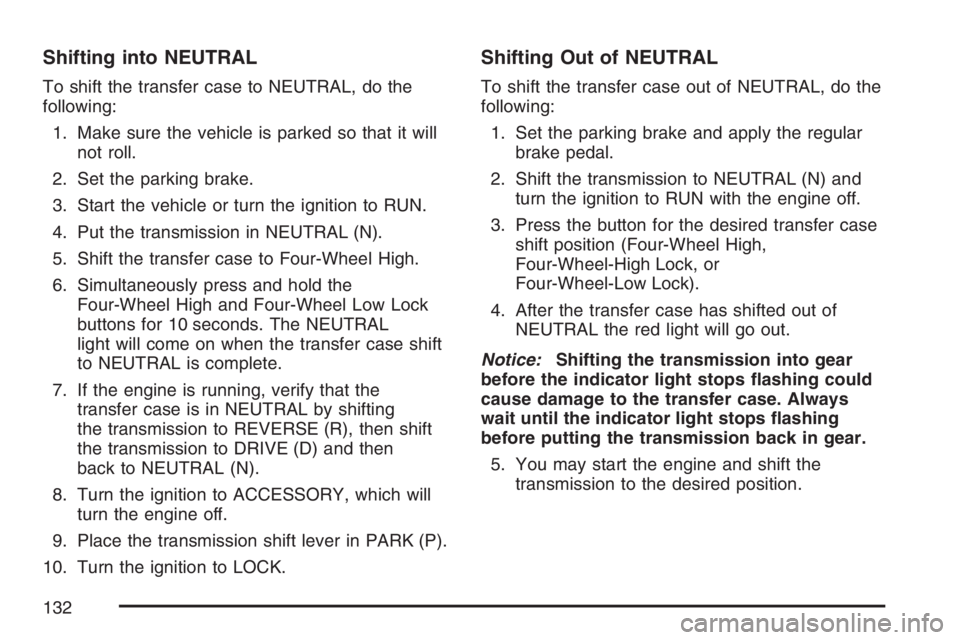
Shifting into NEUTRAL
To shift the transfer case to NEUTRAL, do the
following:
1. Make sure the vehicle is parked so that it will
not roll.
2. Set the parking brake.
3. Start the vehicle or turn the ignition to RUN.
4. Put the transmission in NEUTRAL (N).
5. Shift the transfer case to Four-Wheel High.
6. Simultaneously press and hold the
Four-Wheel High and Four-Wheel Low Lock
buttons for 10 seconds. The NEUTRAL
light will come on when the transfer case shift
to NEUTRAL is complete.
7. If the engine is running, verify that the
transfer case is in NEUTRAL by shifting
the transmission to REVERSE (R), then shift
the transmission to DRIVE (D) and then
back to NEUTRAL (N).
8. Turn the ignition to ACCESSORY, which will
turn the engine off.
9. Place the transmission shift lever in PARK (P).
10. Turn the ignition to LOCK.
Shifting Out of NEUTRAL
To shift the transfer case out of NEUTRAL, do the
following:
1. Set the parking brake and apply the regular
brake pedal.
2. Shift the transmission to NEUTRAL (N) and
turn the ignition to RUN with the engine off.
3. Press the button for the desired transfer case
shift position (Four-Wheel High,
Four-Wheel-High Lock, or
Four-Wheel-Low Lock).
4. After the transfer case has shifted out of
NEUTRAL the red light will go out.
Notice:Shifting the transmission into gear
before the indicator light stops �ashing could
cause damage to the transfer case. Always
wait until the indicator light stops �ashing
before putting the transmission back in gear.
5. You may start the engine and shift the
transmission to the desired position.
132
Page 133 of 570
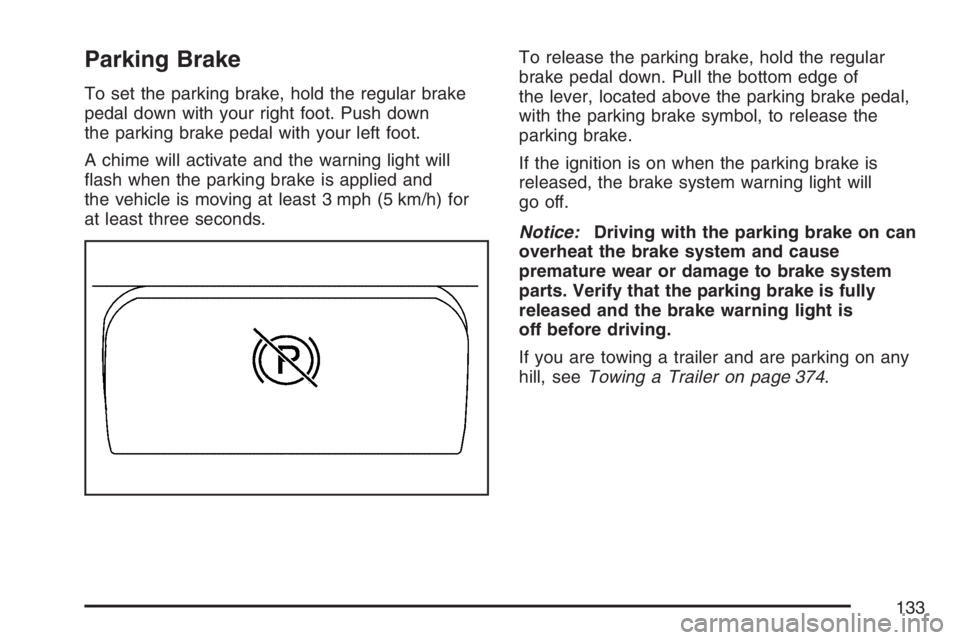
Parking Brake
To set the parking brake, hold the regular brake
pedal down with your right foot. Push down
the parking brake pedal with your left foot.
A chime will activate and the warning light will
�ash when the parking brake is applied and
the vehicle is moving at least 3 mph (5 km/h) for
at least three seconds.To release the parking brake, hold the regular
brake pedal down. Pull the bottom edge of
the lever, located above the parking brake pedal,
with the parking brake symbol, to release the
parking brake.
If the ignition is on when the parking brake is
released, the brake system warning light will
go off.
Notice:Driving with the parking brake on can
overheat the brake system and cause
premature wear or damage to brake system
parts. Verify that the parking brake is fully
released and the brake warning light is
off before driving.
If you are towing a trailer and are parking on any
hill, seeTowing a Trailer on page 374.
133
Page 134 of 570
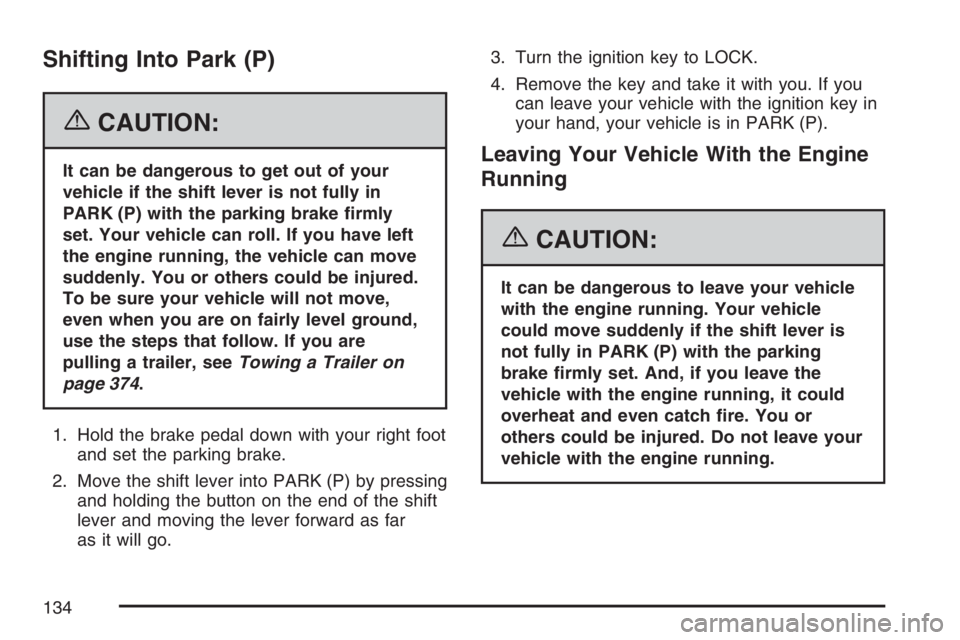
Shifting Into Park (P)
{CAUTION:
It can be dangerous to get out of your
vehicle if the shift lever is not fully in
PARK (P) with the parking brake �rmly
set. Your vehicle can roll. If you have left
the engine running, the vehicle can move
suddenly. You or others could be injured.
To be sure your vehicle will not move,
even when you are on fairly level ground,
use the steps that follow. If you are
pulling a trailer, seeTowing a Trailer on
page 374.
1. Hold the brake pedal down with your right foot
and set the parking brake.
2. Move the shift lever into PARK (P) by pressing
and holding the button on the end of the shift
lever and moving the lever forward as far
as it will go.3. Turn the ignition key to LOCK.
4. Remove the key and take it with you. If you
can leave your vehicle with the ignition key in
your hand, your vehicle is in PARK (P).Leaving Your Vehicle With the Engine
Running
{CAUTION:
It can be dangerous to leave your vehicle
with the engine running. Your vehicle
could move suddenly if the shift lever is
not fully in PARK (P) with the parking
brake �rmly set. And, if you leave the
vehicle with the engine running, it could
overheat and even catch �re. You or
others could be injured. Do not leave your
vehicle with the engine running.
134